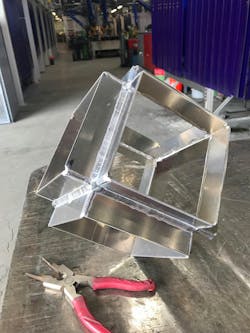AI Won’t Reduce Technician/Trades Jobs, But Will Community Colleges?
AI eats brains jobs
But that zombie won’t eat hands
Be a technician
A few weeks ago, I started teaching a community college electrical engineering technology lab in digital systems basics. It’s a three-hour lab with an additional hour taught in another section by another instructor. I give an overview lecture on the background theory for the lab for about 30-45 minutes at the start of my lab session.
Our first labs were in basic lab equipment usage (oscilloscopes, DMM, power supplies) with a dip of the toe into troubleshooting. Students had to figure out the connectivity in the breadboard they would be using in subsequent labs.
In that first week, they didn’t have knowledge of Ohm’s law, of what a circuit is, or why it’s a bad idea to connect an ammeter across a voltage source. So, they got my knowledge firehose aimed at them, turned down to digestible basics squeezed into 45 minutes or so. Happily, no ammeters got smoked...
Think Like an Engineer
From the onset, I’ve been determined to have my entire class converge, around mid-semester, into “thinking like an engineer.” I structured a lab report template for them to use that followed the scientific method, as well as me forcing them to be objective by having them write their lab reports in third person only — not an easy transition for former human beings who will have engineering brains retrofitted within two years.
I provide bespoke feedback on every lab report written by each of my students, which pretty well knocks my gross wages to much less than I could make flipping a burger. But someone has to do it versus delivering the lecture/lab physical hours, doing an autoscored quiz, and calling it a day for reasonably good money on an academic gravy train wage that’s more befitting of an engineer with 45 years of related work experience.
Fortunately, not everyone cares about the effective-wage math (or is dumb enough not to do the calculation) and is primarily in it to teach and to mold the clay. Unfortunately, my banks don’t care about my intellectual philanthropy and only accept cash.
Unless you game it like many do, McCollege teaching is a bad way to make a living because your entry pay is offered at the same level as that of a new grad, even if you do bring a half century of industry battle scars to the outfit. The administrators, the people that sign union contracts, of course get paid for related industry experience. My boss, the Dean, is still looking into lifting me out of the poverty wages I tentatively accepted because the semester was imminently starting and 18 students were about to get dropped out of their lab class for lack of staffing.
How It Started
A few years ago, I put my name into the part-time faculty pool, not really expecting to hear from the college. This came about from me taking a TIG welding class (for fun, see the figure). I found myself teaching basic tool use to capstone-project students who didn’t have fathers show them how during their upbringing, which I was lucky to have. I’ve had groups of co-op students working for me in the past and came to realize I missed teaching stuff to students.
Thanks to the aggressive onset of AI, students are starting to realize that soft skills, like coding, and even many aspects of entry-level engineering are allegedly AI-replaceable jobs at some point in the near future. So, both the students and their parents have come up with a sane, defensible, career strategy: It puts forth the hypothesis that hands-on trades/professions would remain lucrative and in demand, if not increasing in demand, because someone has to twiddle the knobs in the lab, build prototypes, and troubleshoot and repair/maintain the hardware.
While that IV drip next to your hospital bed can mean little sleep due to its alarms — the only time you really pay attention to it — the machines are kept running, and sound an alarm when the medication runs low, thanks to biomedical technicians that the hospitals keep on staff and that our college electronics engineering technology (EET) program produces as a “product.” In my opinion, we produce an employable “product,” produced by the seasoned craftspeople on faculty.
So, I now find myself in a position as part-time faculty (technology editor for Electronic Design remains my full-time Endeavor) teaching and developing the skills of the future hands and brains of engineering technologists.
Some of the future technologists will go into the biomedical track offered by Portland Community College’s EET program. Others may go into mechatronics by studying courses specifically tailored for motion and control. For example, I'm scheduled to teach Hydraulics & Pneumatics next semester as part of that specialization track to address part of the robotics and automation expertise the students graduate with.
Where the Jobs Should Be
With the very-real AI jobs threat to brains-only jobs, it makes perfect sense that enrollments in EET are, in fact, at record levels (since COVID) this term. With the added conjunction of our seasoned “boomer” engineering staff starting to retire from teaching, it led the phone call I received to join the faculty team as a part-time instructor and me getting onboarded pretty quickly so that the school could add a section to the Digital Electronics lab course to meet enrollment demand. Personally, I don’t see EET enrollments decreasing if this AI bubble we’re in doesn’t pop.
However, other forces are in play:
“At the end of September [2025], [Oregon] Governor Kotek called on state agencies, including the Higher Education Coordinating Commission, to help close a projected $372.7 million gap in the state’s current budget, which runs through 2027. On October 7, all state agencies were instructed to outline what 5% reductions to their budgets would look like. As a result, HECC has been directed to ask Oregon’s community colleges and universities to engage in reduction scenario planning.”
“Reduction scenario planning.” In my day, it was called “layoffs.”
The school is seeing budget shortfalls (partly thanks to Federal myopia, largely due to massive Federal cuts to Oregon’s share of the tax pie Oregon surpluses to DC, and partly thanks to administrative bloat that’s inevitable in many organizations) and is looking to cut back on course offerings as a broadbrush strategy. It’s an effort to reposition the college to focus on being a transfer institution for Oregon’s Universities, which are also being asked by Spending-Tina to cut budgets by 5%. It doesn’t math, but administrators don’t teach math.
On the trades side, administrators are inadvertently pushing unwilling lemmings over the AI engineering degree cliff, i.e., in the name of “profit” for a public college.
While this strategy of feeding universities may be sound for many disciplines, the EET department also feeds universities. However, it primarily teaches both the needed understanding and hands-on skills that differentiate an EE technologist from a Bachelor’s engineer.
Engineering an Influx of Engineering Technologists
Organizations that must replenish retiring boomers and companies that need to be able to prototype, build, and maintain all of the magical devices that AI promises to engineer require an influx of engineering technologists. Someone with skills and knowledge has to keep critical medical equipment running, keep assembly lines rolling, keep fab wafers moving, repair our electric vehicles, or fix equipment in the field, as examples.
Like many corporations, the school seems to have gotten fat around its wasteline[sic] — the part that doesn’t do the lifting, the moving, or the brain function (teaching). Management, which decides who or what to cut, very rarely falls on its own cost-cutting sword, whether in the private, public, or academic sector.
Basic accounting is all about delivering bottom line profitability in corporations, and it’s weird for me to see a public academic institution’s president talk about the school’s “profitability.” Perhaps failed businessmen have become society’s new role models, where hype is the fuel of fake success. Nobody builds anything, and a company gives money to a startup so that the startup can buy its products to generate... “revenue”?
What’s even more weird is the administrators’ notion of canceling class offerings that have higher costs (things like labs that have capital equipment associated with credit hours earned), despite increased student headcount supporting additional course section offerings — where students paid proportionally for tuition (revenue) and paid costs directly (material fees, etc).
In other words, if you have 60 students in the program as freshmen, turn them away by hypothetically throttling subsequent semesters’ essential offerings to 20 students. You might have 20 drop out, but what happens to the other 20 because EET enrollment increased (do they lawyer up?).
Are the administrators doing the ugly math on ICE chasing off college student headcount without spelling it out? The enrollment being down 15% says, to me, that foreign students, documented or otherwise, are no longer chasing an American education. If true, it seems to me like the school merely has been caught flat-footed with a high-school recruiting problem to boost that top line — the one that increases profit.
Classless Cuts
The notion of cutting top-line revenue to increase bottom-line profitability defies logic and basic accounting principles because every dollar brought in from student signup flows to the bottom line, apart from a subtraction for instructor costs. The buildings and bureaucrats’ overhead cost doesn’t change much, and, in fact, that loaded cost per student goes down with increased student headcount, doesn’t it?
So, the college appears to be bent on cutting availability of classes for those students looking to get a hands-on education to be employable. The school appears to be driving its preliminary decisions based upon a study someone published last year on decreasing enrollment projections (reinforced by the likes of Silicon Valley bros saying college isn’t necessary, because... AI). This, despite programs like EET seeing increases in enrollment this fall semester and the college collectively being down by 15% from plan in enrollment, as the study predicted.
The hands-on skills industry needs, and its hiring, are derived from the very labs and facilities that the administrators are allegedly looking to cut back. The hands-on skills are being played down to become a credit-transfer mill for higher education institutions that AI threatens for job prospects. It’s the increased enrollment in hands-on technician training that’s being DRIVEN, and logically demanded, by AI.
The training and knowledge corporate America got for free from taxpayers and student tuition is now in funding jeopardy. Programs clearly need targeted grants from companies that would be investing in having a pool of graduated technicians.
I can’t help but wonder if there were only 10 administrators for the whole school, each leveraging their productivity with AI that promises to cut overhead costs in the 30,000-enrolled college’s entire administration and reduction-scenario-ing everyone else, whether that lean administration would reach the same conclusion about cutting back on the hands-on Associates’ degrees creating an employable, skilled “product”?
I think that feeding more students into the credit transfer system should have the same effect as closing three of the four lanes on a busy interstate highway: The high school grads who are going directly into the Bachelor’s programs get choked off in heavy traffic heading for the same destination. The most threatened professions by AI, those without hands-on skills, will be congested due to college feed-in policy.
Meanwhile, the skilled trades, the ones that are AI-proof, get starved by artificial throttling of college course capacity by that very same policy because general enrollment is down, and administrators seem to be of the opinion it’s fair to cut everyone equally.
Signups by students for trades courses are top-line growth, which flows to the bottom line if capacity is under-utilized. The college administration is creating constrained course capacity limitations as the result of other programs feeling the bite of tight money and no jobs at graduation. Yes, writing, journalism, history, even illustration jobs are being gobbled up by AI.
Federal cuts notwithstanding, if Corporate America expects to have a pool of available technicians and tradespeople, it will need to step up targeted grants to community colleges, like Portland Community College, to keep administrators from throttling the supply of employable technologists and technicians. Without skilled hands, and brains, there’s no way American companies, infrastructure, and medical facilities, or your electric car, can function.
Andy's Nonlinearities blog arrives the first and third Monday Tuesday of every month. To make sure you don't miss the latest edition, new articles, or breaking news coverage, please subscribe to our Electronic Design Today newsletter. Please also subscribe to Andy’s Automotive Electronics bi-weekly newsletter.
About the Author
Andy Turudic
Technology Editor, Electronic Design
Andy Turudic is a Technology Editor for Electronic Design Magazine, primarily covering Analog and Mixed-Signal circuits and devices. He holds a Bachelor's in EE from the University of Windsor (Ontario Canada) and has been involved in electronics, semiconductors, and gearhead stuff, for a bit over a half century.
"AndyT" brings his multidisciplinary engineering experience from companies that include National Semiconductor (now Texas Instruments), Altera (Intel), Agere, Zarlink, TriQuint,(now Qorvo), SW Bell (managing a research team at Bellcore, Bell Labs and Rockwell Science Center), Bell-Northern Research, and Northern Telecom and brings publisher employment experience as a paperboy for The Oshawa Times.
After hours, when he's not working on the latest invention to add to his portfolio of 16 issued US patents, he's lending advice and experience to the electric vehicle conversion community from his mountain lair in the Pacific Northwet[sic].
AndyT's engineering blog, "Nonlinearities," publishes the 1st and 3rd monday of each month. Andy's OpEd may appear at other times, with fair warning given by the Vu meter pic.


